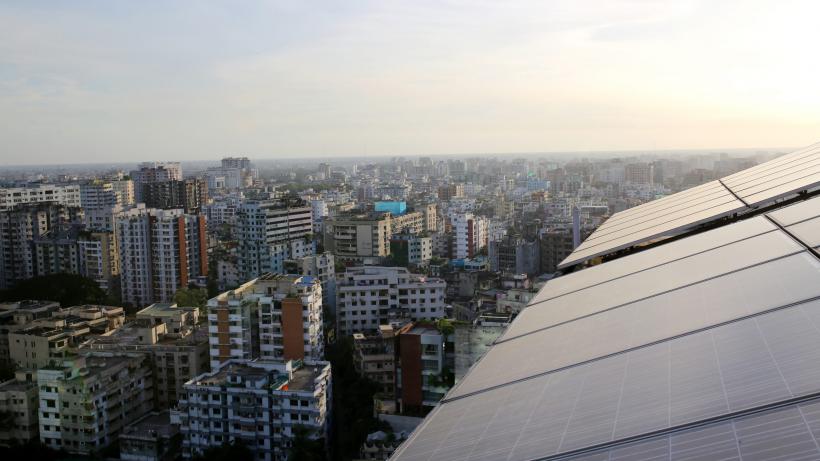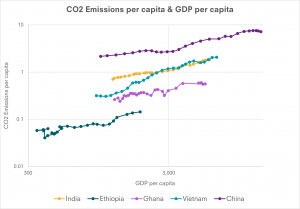
Can growth truly be sustainable?
A sustainable approach to growth provides economic opportunities for the poor, builds resilience, and prepares low-income countries for the impacts of climate change while limiting current emissions and environmental degradation. Yet as massive investments roll out to support the global COVID-19 recovery, 2021 is projected to be the second highest year in history for global emissions. At this juncture, now is the time for governments to fully embrace sustainable growth.
Over the last few decades, economic growth has provided the foundation for increased prosperity globally, lifting millions of people out of extreme poverty. It has become clear, however, that this growth has accompanied steep costs to the planet, such as deforestation, environmental damage, pollution, and carbon emissions driving climate change, among others. In the face of environmental degradation, the COVID-19 pandemic is threatening generations of progress on poverty, with the worst-case scenarios estimating an additional 150 million people living in extreme poverty by the end of the year. Despite these setbacks, improving economic recovery remains the only way out.
Why growth is still needed
The last four decades have increased global prosperity and improved the livelihoods of hundreds of millions of people around the world. Up until the onset of the COVID-19 pandemic, the world’s GDP per capita had more than doubled and the share of the world’s population living in extreme poverty (with less than $1.90 per day) was one-fourth of what it was 40 years ago.
China is the most striking example of how growth reduces poverty. Home to nearly half of the world’s poor in 1990, the country celebrated the end of extreme poverty in February 2021. But it is not an isolated example. From 1995 to 2015, Ethiopia experienced an average growth rate of 8% as extreme poverty rates dropped from 27.8% to 8.9%. Despite these staggering achievements, 10% of the world’s population still lives in extreme poverty – more than 750 million people. Since the onset of the COVID-19 pandemic, poverty indicators have considerable worsened, and for roughly half the countries in sub-Saharan Africa, extreme poverty is on the rise.
The increasing concentration of extreme poverty in the world’s poorest countries – with more than 40% living in sub-Saharan Africa – emphasises the desperate need for growth beyond typical efforts of wealth redistribution. While inequality is a pressing issue in many developing (and developed) countries and should be a policy focus, focusing solely on reducing inequality would be insufficient to reduce poverty significantly.
Moreover, the quest to get people over the $1.90/day threshold should not be the sole objective. A person’s life improves only marginally when their daily income increases from $1.80 to $2.00/day. More than 85% of the world’s population lives with less than $30/day: the threshold at which most high-income countries define poverty. To significantly reduce global poverty using this threshold, the world’s economy would need, at a minimum, to quintuple in size (whereas it has only doubled in the last 25 years).
Low-income and lower-middle-income countries (LMICs) drastically need growth. And not growth in terms of boosting macroeconomic indicators, but growth as a series of structural transformations that lead to sustained increases in the productivity of workers and firms. Growth should not be an end product or a numeric target but an inclusive process, one that unlocks the economic potential of everyone. When a large number of people develop firms, when well-paying jobs are created, when workers gain new skills, when cities expand and exports grow, the social and economic well-being of millions of people improve.
Trade-offs of growth
Triggering the growth process in LMICs is not a new challenge. However, the global challenges raised by the depletion of natural resources, damages to biodiversity, local pollution, and climate change highlight the tension that exists between growth and the externalities it generates. We need an inclusive pathway that delivers the economic growth and poverty reduction that developing countries critically need, while minimising negative impacts on current and future generations – we need sustainable growth.
Leapfrogging from subsistence agriculture to more productive sectors is necessary to raise incomes and make people less vulnerable to weather shocks and environmental catastrophes. Historically, this transition has always occurred with simultaneous increases in energy consumption and greenhouse gas (GHG) emissions. Taking countries which have experienced high growth over the past decades, the figure below illustrates how increases in income have been accompanied by increases in CO2 emissions per capita. Thus far, structural transformation has mostly been powered by fossil fuels, but new technologies may allow increases in productivity while minimising the impact on the environment and lead the way for sustainable growth.

Source: Author’s calculations using World Bank data on GDP and emissions
The past and current contributions of LMICs to the current CO2 atmospheric concentrations, however, are only a drop in the ocean. But, if the high-income countries that have contributed the most to historic emissions (such as those in Europe and the US) abide by their Nationally Determined Contributions (NDCs) in the Paris Agreement by 2050, LMICs could contribute a sizable amount to global emissions by that time. The choices made today by LMICs, where most of the increase in energy consumption in the coming decades will stem from, will impact GHG emissions in the future.
Additionally, the need to act on mitigation policies in LMICs should be motivated by more than their future responsibility for global CO2 emissions. For example, India, Bangladesh, and Pakistan are home to 17 of the 20 most polluted cities in the world, which caused around 1.17 million deaths in 2019. Focusing on reducing local air pollution and environmental damage, issues that may be politically easier for leaders to act upon than global climate change, can also have positive impacts.
A different type of growth
The fundamental vision behind sustainable growth is that the tension between promoting growth and preserving the environment should not be zero-sum. Finding a path that brings structural change while bringing emissions to zero requires developing technological and policy solutions to the challenges that currently prevent countries from reaching both objectives. How can developing countries best manage the intermittency issues associated with low carbon energy sources? How can credit constraints and other capital market imperfections preventing the adoption of renewables be overcome? What are the political economy factors blocking the adoption and implementation of laws, regulations, and fiscal policies that protect the environment, restrict illegal logging and fishing, and constrain unfair advantages fossil fuel companies have over other emerging technologies?
Sustainable growth is directly concerned with the impact climate change will have on LMICs. Whether or not countries respect their Paris Agreement targets over the coming decades, the GHG emissions accumulated thus far will already yield severe climate impacts. Because the impact of climate change will be stronger between the tropics, LMICs will be more affected than high-income countries due to their greater reliance on agriculture for employment and lesser resiliency against extreme weather events. Though, as shown in the figure below, resilience to the impact of climate change is correlated with higher GDP per capita. Therefore, transitioning away from subsistence agriculture towards higher productivity jobs can provide one path to significantly reduce climate-related vulnerabilities.

Source: Author’s calculations using ND-Gain (Notre Dame Global Adaptation Initiative) Country Index and World Bank data on GDP and emissions.
Promoting sustainable growth in LMICs thus involves supplying public goods and services with the necessary incentives, regulations, and subsidies that will foster resiliency against future climate disruptions. These climate adaptation measures will ignite efforts to encourage farmers to adopt drought-resilient crops; build cities and infrastructure resilient to storms, flooding, and wide variations in temperatures; anticipate energy demands from the impact of climate change; and develop early warning systems that will be crucial for the foreseeable future.
Lands of opportunity
Sustainable growth in LMICs goes beyond the need for growth to be simply ‘greener’. It is more than a quest to maximise income per unit of GHG emissions, and requires a holistic approach that addresses the degradation of forests and oceans, the depletion of natural resources, and the different forms of pollution in a way that considers the welfare of current and future generations.
The stakes are high, but the opportunities are abundant. Promoting sustainability in high-income countries requires the deconstruction and the re-invention of our production and consumption models. In LMICs, however, the energy supply, infrastructure, and skills that are necessary inputs to promote sustainable growth have yet to be planned. Electricity generation needs to increase in fragile countries if all households are to have access to reliable electricity. Two-thirds of African cities by 2050 have yet to be built. These are incredible opportunities for promoting sustainable growth and designing a pathway towards shared prosperity and resilience.
This moment also offers a tremendous opportunity for a growth reset. Governments around the world are making massive investments to support the recovery from the economic crisis generated by the COVID-19 pandemic. With oil prices so low, it may be tempting to make further investments in fossil fuel-based energy supply. If instead governments choose to prioritise strategies that embrace sustainable growth, this could be a catalytic period to ensure success in reaching the Sustainable Development Goals by 2030.
This blog is part of IGC’s sustainable growth series and introduces the issues discussed at our Growth Reset event.

